Books used by alchemists offer insights into the relationship between these early chemists and their texts. Philip Ball investigates
If you think today’s chemistry textbooks can be hard to follow, consider what a student of alchemy might have been faced with in the late 16th century: ‘Antimony is the true bath of gold. Philosophers call it the examiner and the stilanx. Poets say that in this bath Vulcan washed Phoebus, and purified him from all dirt and imperfection. It is produced from the purest mercury and sulfur, under the genus of vitriol, in metallic form and brightness. Some philosophers call it the White Lead of the Wise Men, or simply the Lead…’
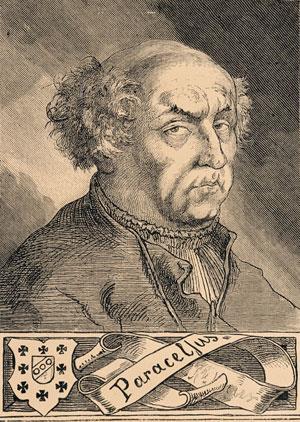
This comes from The aurora of the philosophers– a book attributed to Swiss alchemist and physician Philippus Aureolus Theophrastus Bombastus von Hohenheim, or Paracelsus as he styled himself (1493–1541) – and describes a synthesis of the ‘Arcanum of Antimony’, apparently a component of the philosopher’s stone that transformed base metals into gold. It is, Paracelsus stated, a ‘very red oil, like the colour of a ruby…with a most fragrant smell and a very sweet taste’. The book contains very detailed instructions for making it, provided that you know what ‘aquafortis’, ‘crocus of Mars’ and ‘calcined tutia’ are and that you take care to control the heat of the furnace, in case (the author warns) your glass vessels and perhaps even the furnace itself should shatter.
All this fits the famous image of alchemy depicted by the Dutch artist Pieter Bruegel the Elder around 1558. His engraving The Alchemist shows a laboratory in turmoil, littered with paraphernalia and smoky from the fire, where a savant works urgently to make gold while his household descends into disarray all around him. Bruegel’s engraving set the tone for pictures of alchemists at work over the next few centuries, in which they were often shown as figures of fun, engaged on a fool’s quest and out of touch with reality.
But that caricature doesn’t quite stand up to scrutiny. For one thing, despite its mysterious language that only other alchemical adepts would understand, Paracelsus’s experimental procedure is carefully recorded. It’s not that different, once you grasp the arcane names and techniques, from something you’d find in textbooks of chemistry four centuries later. The aim – transmutation of metals – might seem misguided with the benefit of hindsight, but there’s nothing crazy about the methods.
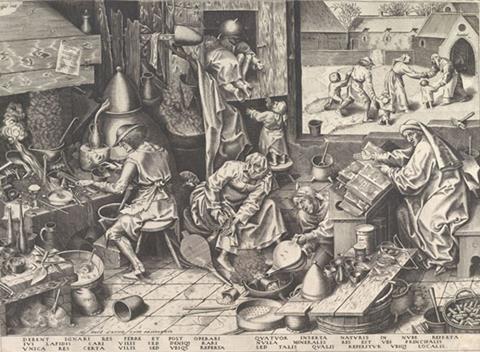
Secondly, the experimentation depicted in Bruegel’s picture isn’t as random as it might first appear. It is being carefully directed by a scholar who sits at the back reading a book. (The text is, however, satirical: the scholar points to the words ‘Alge mist’, a pun on ‘alchemist’ meaning ‘all is failed’, and we see the alchemist’s future in the window as he leads his family to the poorhouse.)
Books are ubiquitous in paintings of alchemists, which became a genre in their own right in the 17th century. Very often the alchemist is shown consulting a text, and even when he is puffing the bellows and experimenting himself, a book stands open in front of him. Sometimes it’s the act of reading, rather than the experiments, that supplies the satire: in the painting An alchemist at work by the Dutch artist Mattheus van Helmont, the papers tumble from the desk to litter the floor in ridiculous excess.
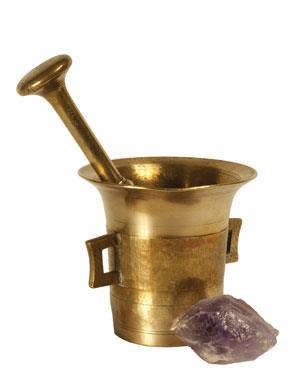
‘The use of books and texts in alchemical practice may not be discussed frequently, but it becomes obvious when looking at the actual manuscripts used by alchemists and at the multitude of paintings that depict them,’ says Amanda Shields, curator of fine art at the Chemical Heritage Foundation (CHF) in Philadelphia, US.
The complex relationship of alchemists to their books is explored in a current exhibition at the CHF called Books of secrets: writing and reading alchemy. It was motivated by the foundation’s recent acquisition of 12 alchemical manuscripts, mostly from the 15th century. Among the new acquisitions was one of just six existing complete copies of the highly influential Pretiosa margarita novella (Precious new pearl) supposedly by the 14th-century Italian alchemist Petrus Bonus.
The CHF already possessed one of the most substantial collections of paintings of alchemists in the world, mostly from the 17th to the 19th centuries. And while being aware of the difference between the age of the books and the paintings, Shields and the CHF’s curator of rare books James Voelkel saw an opportunity to use these two resources to explore what books meant for the alchemists and early chemists: who wrote them, who they were intended for and how they were used.
Telling secrets
Alchemy wasn’t all about making gold. In the 16th century just about any chemical manipulation – whether to make medicines, pigments and dyes, or simple household substances such as soap – would have been regarded as alchemy. There were many different styles of books written on the topic and this is one reason why the notion of an ‘alchemical literature’ is ambiguous. Some writers, such as the late 16th-century physician Michael Maier, described the subject in mystical terms that could not be easily understood outside of highly esoteric circles. Others, such as the German Georg Bauer (known as Agricola), wrote highly practical manuals such as a treatise on mining and metallurgy De re metallica (1556). Paracelsus’s works, which became popular in the late 16th century, were a mixture of convoluted ‘chemical philosophy’ and straightforward recipes for making drugs and medicines.
How-to manuals known as Kunstbüchlein also appeared during the Renaissance. They were hotchpotch collections of recipes from all manner of sources, including classical encyclopedias and ill-reputed medieval books of magic. They often styled themselves as ‘books of secrets’, which of course made them sound very alluring – but they were more likely to give you a mundane recipe for curing toothache than the secret of how to turn lead into gold.
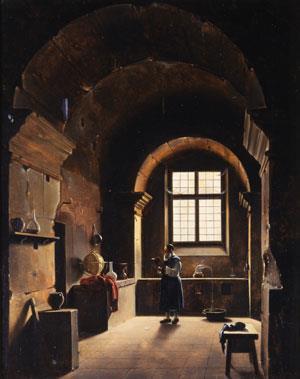
Indeed ‘secrets’ weren’t necessarily about forbidden knowledge at all. According to historian of science William Eamon of New Mexico State University in Las Cruces, US, ‘the term was used to describe both trade secrets, in the sense of being concealed, and also tricks of the trades, in other words techniques.’ Eamon adds that the word secrets also ‘carried a lot of weight owing to the medieval tradition of esoteric knowledge’, which remained prominent in alchemy during the Renaissance. This glamour meant that the term could be useful for selling books.
This tradition of compiling ‘secrets’ was an old one. American historian of experimental science and magic Lynn Thorndike suggested that the most popular book in the Middle Ages might have been Secretum secretorum (which translates as Secret of secrets – how much more enticing a title could you get?). This book has obscure origins probably in the Islamic literature from around the 10th century, and includes sections on alchemy, medicine, astrology, numerology, magic and much else.
Intentional obscurity
But even if many of these ‘secrets’ were not worth keeping, alchemy was different: it could appear genuinely dangerous. If it was possible to make gold, what would that do to the currency and the economy? It was largely this kind of worry, rather than any perception that alchemy was wrong-headed, that gave it a bad reputation. In 1317 Pope John XXII made alchemy illegal and imposed harsh sentences on anyone found guilty of trying to make gold.
There was also concern – some of it justified – that alchemists were swindlers who were duping people with fake gold. The image of the alchemist as a trickster who blinded gullible clients with incomprehensible jargon was crystallised in the English writer Ben Jonson’s 1610 play The Alchemist, in which his wily charlatan Subtle is a figure of fun. What’s more, alchemy was often associated with religious non-conformism.
In view of all this, the genuine alchemist had to tread carefully. That’s one reason why alchemical texts were often written with ‘intentional obscurity’, according to Voelkel. If you wrote cryptically, you could always argue your way out of accusations that you’d said something heretical or illegal.

But the alchemical writers also felt that their knowledge held real power and should therefore be made unintelligible to lay people. A third motivation will be familiar to anyone who has ever read postmodernist academic works: if you wrote too plainly, people might think that what you were saying is trivial, whereas if it was hard to understand then it seems profound and mysterious. Even if the recipes were straightforward, you wouldn’t get far without knowing the ‘code names’ for chemical substances: that ‘stinking spirit’ is sulfur, and the ‘grey wolf’ or ‘sordid whore’ is stibnite (antimony sulfide), for example.
Probably all of these motives for concealment and obfuscation were important to some degree, says Eamon. But he suspects that the major factor was ‘to enhance the status and mystery of the work’. Also, he adds, ‘one shouldn’t underestimate the sheer inertia of tradition: secrecy was a very ancient tradition and always connected with the idea of initiation. Its hold over alchemy was strong even after there was little need for it.’
Even Robert Boyle, whose The sceptical chymist (1661) has often been misinterpreted as a dismissal of all of alchemy rather than just its mystical and cryptic excesses, ‘employed elaborate coding devices to conceal his recipes’, says Eamon – especially those involved in gold-making. Despite insisting that his peers should be less obscure and cagey, Boyle wasn’t averse to it himself. ’He may simply have protecting his reputation,’ says Eamon. He didn’t want to be associated with an art many regarded as foolish. Isaac Newton, whose notebooks attest to extensive alchemical experimentation, was similarly guarded about that work.
The alchemist’s library
Given the diversity of sources, what would an alchemist have had in his library? The answer would depend somewhat on the kind of alchemy (or chymistry, the term used for the transition to genuine chemistry) they did, says Eamon. ‘The more practically inclined alchemists would probably have owned few books,’ he says, ‘and they would probably have been heavy on books on metallurgy such as Agricola’s De re metallica and works such as the kunstbüchlein.’
Alchemists who were more interested in gold-making and the more esoteric mysteries of the art ‘would have been drawn to works such as those of [the pseudonymous] Basil Valentine, one of the more celebrated chemists of the period, such as The triumphal chariot of antimony’. The medieval texts attributed to the Arabic writer Jabir ibn Hayyan would also have been popular among this sort of alchemist, Eamon adds.
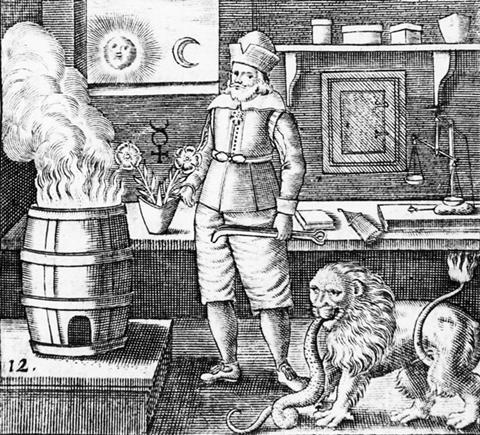
Alchemists who wrote about distillation, such as the Frenchman John of Rupescissa and authors who wrote under the name of the Spanish philosopher Ramon Llull, were popular in the 16th century, especially for alchemists mainly interested in medicine. ‘Works by Paracelsus and his followers would also be represented in the chymist’s library,’ says Eamon. ‘For many alchemists, books of secrets would also have been quite useful, of which the most popular was Alessio Piemontese’s Secreti.’
Boyle had a very large library that included many alchemical works. ‘Unfortunately the library was dispersed after Boyle’s death and no library catalogue exists,’ says Eamon. ‘But historians have been able to identify several of his books from his notes.’ These included De re metallica and works by Paracelsus and German-Dutch alchemist Johann Glauber. Newton’s library is much better catalogued, and included well-used copies of Paracelsus’ On the Transmutation of Metals and an English translation of Novum lumen chymicum by the Polish alchemist Michael Sendivogius.
Dialogue in the lab
The CHF exhibition shows that such alchemical books weren’t at all treated like sacred texts. While they were still hand-copied, these books could cost a fortune, but that didn’t mean they were kept in pristine form. They are well thumbed and evidently much used, sometimes showing signs of a benchtop life just as the later paintings imply. One book, a collection of recipes from Italian and English sources dated around 1470–75, has pages begrimed with what looks like soot, along with loose dirt and other particles in the ‘gutters’ where the pages are bound together. The conservator used by the CHF – Rebecca Smyrl at the Conservation Center for Art and Historic Artifacts in Philadelphia – agreed with Voelkel’s suggestion that these loose particles should not be removed, for he figured that they might be the debris from an actual experiment.
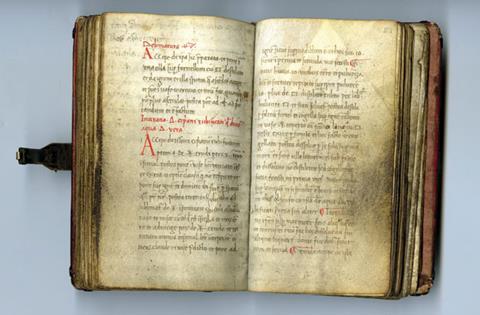
What’s more, the readers scribbled all over the pages. Since paper itself was expensive, you might as well use the original text as your notebook, and margins were left deliberately generous to accommodate the annotations. In a copy of Christophorus Parisiensis’ Opera from 1557 there is not a square centimetre wasted, and the notes are recorded in a neat hand almost too tiny to read without magnification. Readers didn’t just mine the book for information: they engaged in a dialogue with the author, making corrections or arguing about interpretations. ‘There was a real conversation going on,’ says Erin McLeary, director of the CHF museum. These markings attest that the books were anything but status symbols to be filed away ostentatiously on the shelf. ‘Reading was a huge part of alchemical practice,’ says Voelkel.
The CHF’s newly acquired manuscripts are particularly revealing because they date from the time when print culture was emerging. The printing press lowered the financial and practical barriers to book ownership. ‘It made alchemical books widely available and relatively affordable,’ says Eamon. ‘You can already see the decline of the notion of books as luxury items in the early 16th century.’ Printing enabled the Kunstbüchlein manuals to become bestsellers in the early 16th century. ‘They were cheaply printed, widely translated and produced in large numbers,’ says Eamon.
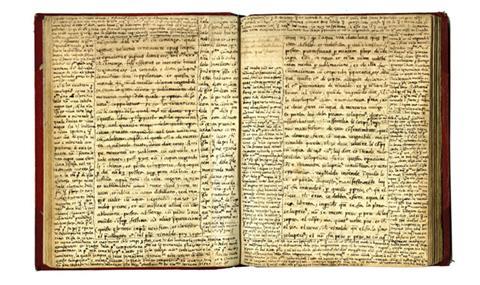
Piemontese’sSecreti went through over 100 editions, and its likely author Girolamo Ruscelli seems to have been something of a hack (the polite term was poligrafo) churning out whatever his publisher demanded. Print culture drove the trend of writing books in native languages rather than Latin (which many potential buyers couldn’t read), and this opening up of new audiences was exploited as much by religious dissenters – Martin Luther was one of the first to spot the possibilities – as by publishers of scientific books.
The transition to print is displayed in the CHF’s books. The early typefaces were designed to look like handwritten text, and some of the abbreviations used by scribes – such as the ampersand (&), shorthand for the Latin et– were carried over to print. Some early printed books left a space at the start of chapters for the ornate initial capital letters to be added by hand. Quite often, however, the owners decided to save on the expense and therefore the chapters begin with a blank.
As time passed and alchemy turned into chymistry and then chemistry, the image of the alchemist recorded by the painters became more tolerant and less satirical. In the hands of one of the most prolific and influential artists of this genre, David Teniers the Younger (1610-1690) of Antwerp, the alchemist is less Breugel’s foolish agent of chaos and more a sober laboratory worker. If his floor is still strewn with vessels of brass, glass and clay, that’s simply because it allows Teniers to show off his skill at painting textures. In The Village Chemist (1760) by German painter Justus Juncker, the physician sits calmly taking notes in his well-lit study-workshop; Frenchman François-Marius Granet’s The Alchemist (early 19th century) shows a sober, monk-like figure in a spacious, sparsely furnished chamber; and British painter Charles Meer Webb’s The Search for the Alchemical Formula (1858) makes the alchemist a romanticised, Gothic savant. What remains consistent throughout the ages is that the alchemist is reading or writing: the books are always there.
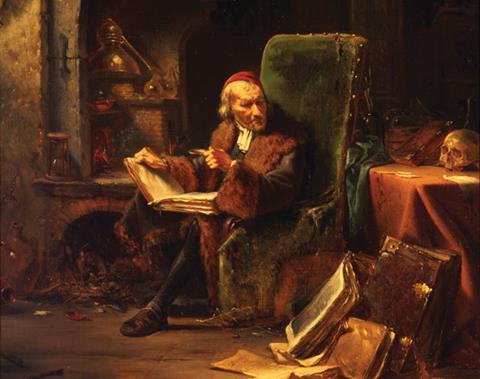
Philip Ball is a science writer based in London, UK
References
Chemical Heritage Foundation Books of secrets: writing and reading alchemy exhibition













No comments yet